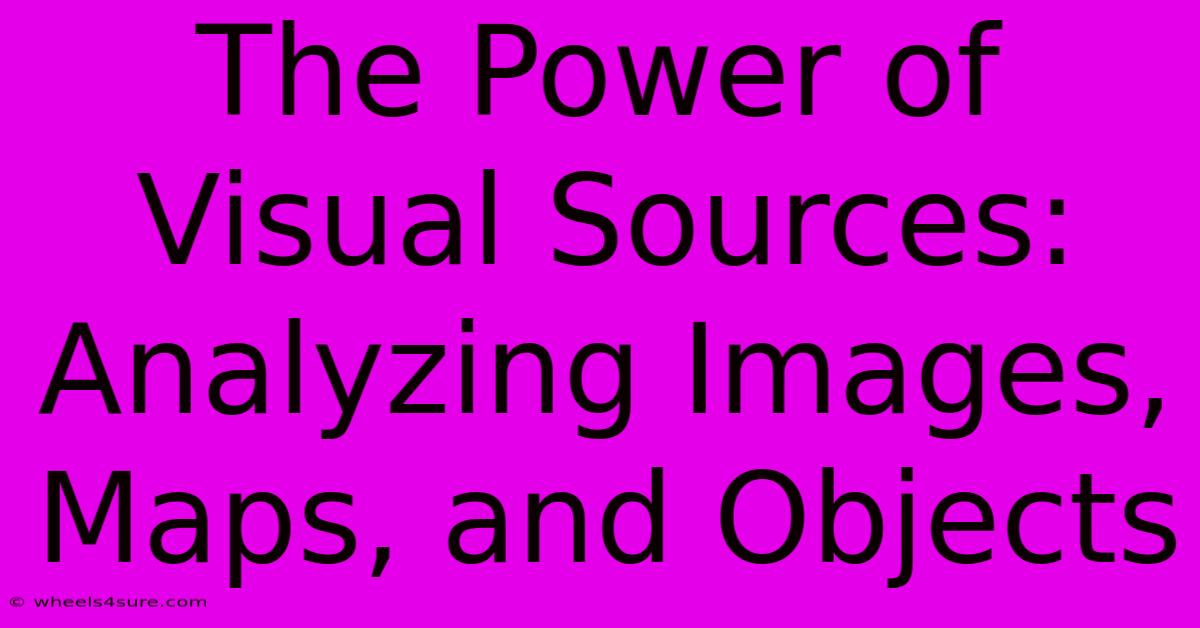The Power Of Visual Sources: Analyzing Images, Maps, And Objects

Table of Contents
The Power of Visual Sources: Analyzing Images, Maps, and Objects
In today's information-saturated world, the ability to critically analyze visual sources is more crucial than ever. Images, maps, and objects aren't just pretty pictures; they are powerful tools that communicate information, perspectives, and narratives. Mastering the art of visual source analysis empowers you to become a more informed citizen, a more effective researcher, and a more persuasive communicator. This article explores the power of visual sources and provides practical strategies for analyzing them effectively.
Deconstructing Images: Beyond the Surface
Images, whether photographs, paintings, or digital creations, are rarely neutral. They are carefully constructed to convey specific messages. To analyze an image effectively, consider the following:
1. Context is King:
- Who created the image? Understanding the creator's background, intentions, and potential biases is crucial.
- When was it created? The historical context significantly influences the image's meaning and interpretation.
- Where was it created and for what purpose? The location and intended audience shape the image's message.
2. Composition and Content:
- What is depicted? Identify the key subjects and elements within the image.
- How are the elements arranged? Consider the use of color, light, shadow, perspective, and composition to understand the intended message.
- What emotions or ideas does the image evoke? Analyze the visual cues and their emotional impact on the viewer.
3. Symbolism and Iconography:
- Are there any symbols or icons present? Many images utilize symbolism to convey deeper meanings. Research these symbols to fully understand their significance.
- What is the overall message or narrative being conveyed? Consider the image's purpose: Is it informative, persuasive, emotional, or artistic?
Interpreting Maps: More Than Just Geography
Maps are not simply representations of physical space; they are powerful tools that reflect cultural, political, and social perspectives. Analyzing maps requires paying close attention to several factors:
1. Map Projection and Distortion:
- What type of map projection is used? Different projections distort shapes and sizes in various ways. Understanding these distortions is essential for accurate interpretation.
- What areas are emphasized, and what areas are minimized? The map's projection can influence what features are prominent and which are obscured.
2. Data Representation:
- What data is represented on the map? Identify the type of information being conveyed (e.g., population density, elevation, political boundaries).
- How is the data presented? Analyze the use of color, shading, symbols, and scales to interpret the data effectively.
3. Bias and Perspective:
- Who created the map, and what is their perspective? Maps can reflect biases and agendas, influencing how information is presented.
- What information is omitted? The absence of certain details can be just as significant as what is included.
Examining Objects: Artifacts of the Past and Present
Objects – from everyday tools to grand monuments – offer unique insights into past and present cultures. To analyze an object effectively, consider:
1. Material and Construction:
- What materials were used to create the object? The materials reflect the available resources and technology of the time.
- How was the object constructed? The construction techniques reveal valuable information about craftsmanship and cultural practices.
2. Function and Use:
- What was the object's intended purpose? Understanding its function helps reveal its significance within its cultural context.
- How was the object used in daily life or special occasions? This provides insight into social practices and customs.
3. Symbolism and Meaning:
- What symbols or designs are incorporated into the object? These can reflect religious beliefs, social status, or cultural values.
- What does the object tell us about the people who created and used it? Objects offer a window into the lives, beliefs, and values of past societies.
Conclusion: The Power of Visual Literacy
The ability to effectively analyze images, maps, and objects is a fundamental skill in the 21st century. By employing the strategies outlined above, you can unlock the wealth of information contained within these visual sources and develop a deeper understanding of the world around us. Sharpening your visual literacy skills empowers you to critically evaluate information, formulate informed opinions, and communicate your ideas with greater clarity and impact. This, in turn, leads to a more engaged and participatory role in society.

Thank you for visiting our website wich cover about The Power Of Visual Sources: Analyzing Images, Maps, And Objects. We hope the information provided has been useful to you. Feel free to contact us if you have any questions or need further assistance. See you next time and dont miss to bookmark.
Featured Posts
-
Jeffrey Cheah Son A Sons Rise To Prominence
Apr 03, 2025
-
Alysha Burney How Much Does She Make
Apr 03, 2025
-
Ciaras Age The Power Of Family And Support
Apr 03, 2025
-
Dutertes Reforms Lasting Or Transient
Apr 03, 2025
-
Is Trinidads Age Of Consent In Line With International Standards
Apr 03, 2025
